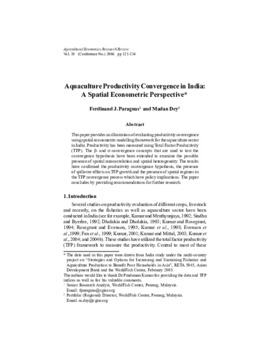Please use this identifier to cite or link to this item:
https://hdl.handle.net/20.500.12348/1877
Aquaculture Productivity convergence in India: A Spatial Econometric Perspective
| dc.creator | Paraguas, F.J. | |
| dc.creator | Dey, M.M. | |
| dc.date.accessioned | 2018-11-19T13:03:41Z | |
| dc.date.available | 2018-11-19T13:03:41Z | |
| dc.date.issued | 2006 | |
| dc.identifier.citation | Agricultural Economic Research Review, 19 (Conference Issue) pp. 121-134 | |
| dc.identifier.uri | https://hdl.handle.net/20.500.12348/1877 | |
| dc.description.abstract | This paper provides an illustration of evaluating productivity convergence using spatial econometric modelling framework for the aquaculture sector in India. Productivity has been measured using Total Factor Productivity (TFP). The ß- and s-convergence concepts that are used to test the convergence hypothesis have been extended to examine the possible presence of spatial autocorrelation and spatial heterogeneity. The results have confirmed the productivity convergence hypothesis, the presence of spillover effects on TFP growth and the presence of spatial regimes in the TFP convergence process which have policy implications. The paper concludes by providing recommendations for further research. | |
| dc.format | application/pdf | |
| dc.language | En | |
| dc.publisher | Agricultural Economics Research Association (India) | |
| dc.source | Agricultural Economic Research Review | |
| dc.title | Aquaculture Productivity convergence in India: A Spatial Econometric Perspective | |
| dc.type | Journal Article | |
| dcterms.bibliographicCitation | Paraguas, F.J.; Dey, M.M. (2006). Aquaculture Productivity convergence in India: A Spatial Econometric Perspective. Agricultural Economic Research Review, 19 (Conference Issue) pp. 121-134 | |
| dc.description.version | Peer Review | |
| cg.coverage.country | India | |
| cg.coverage.region | Southern Asia | |
| cg.identifier.worldfish | 713 | |
| cg.subject.agrovoc | aquaculture | |
| cg.identifier.status | Open access | |
| cg.contribution.worldfishauthor | Paraguas, F.J. | |
| cg.description.theme | Sustainable aquaculture |
Files in this item
This item appears in the following Collection(s)
-
Sustainable aquaculture [2735]
